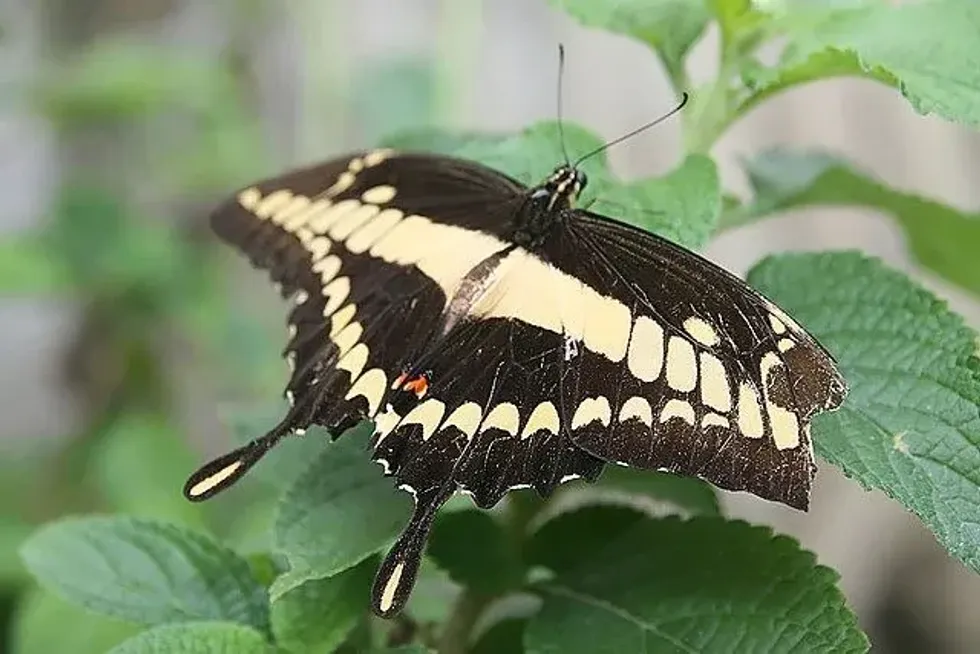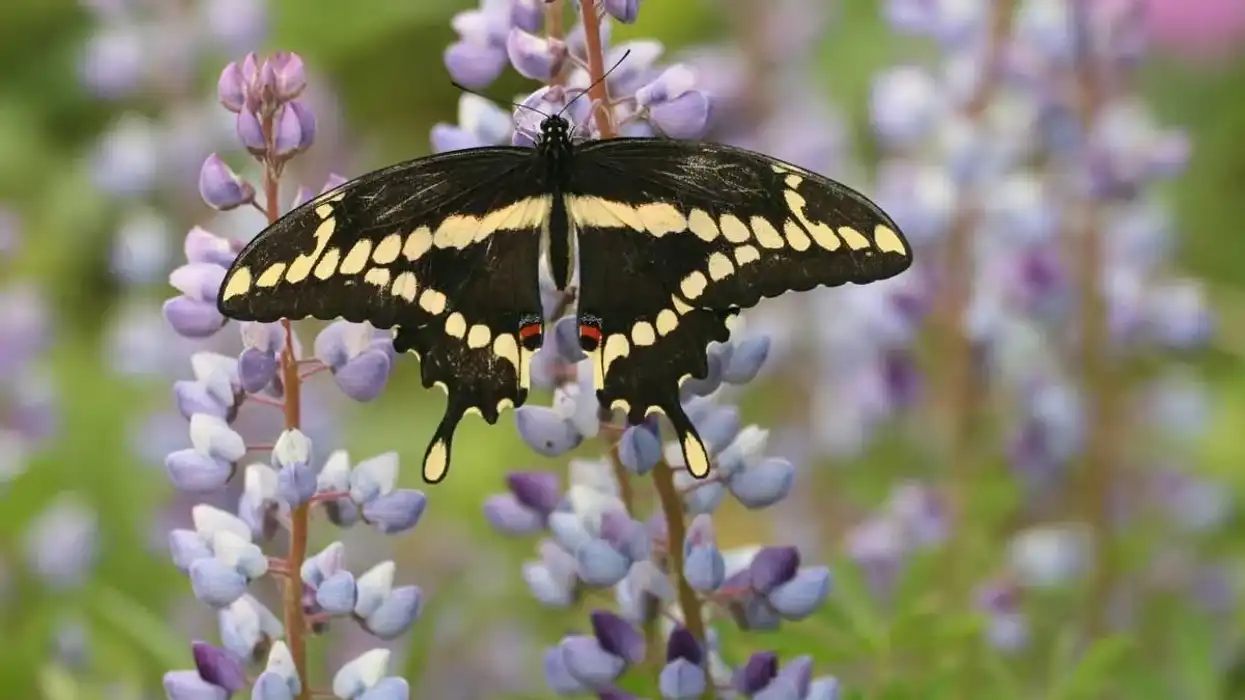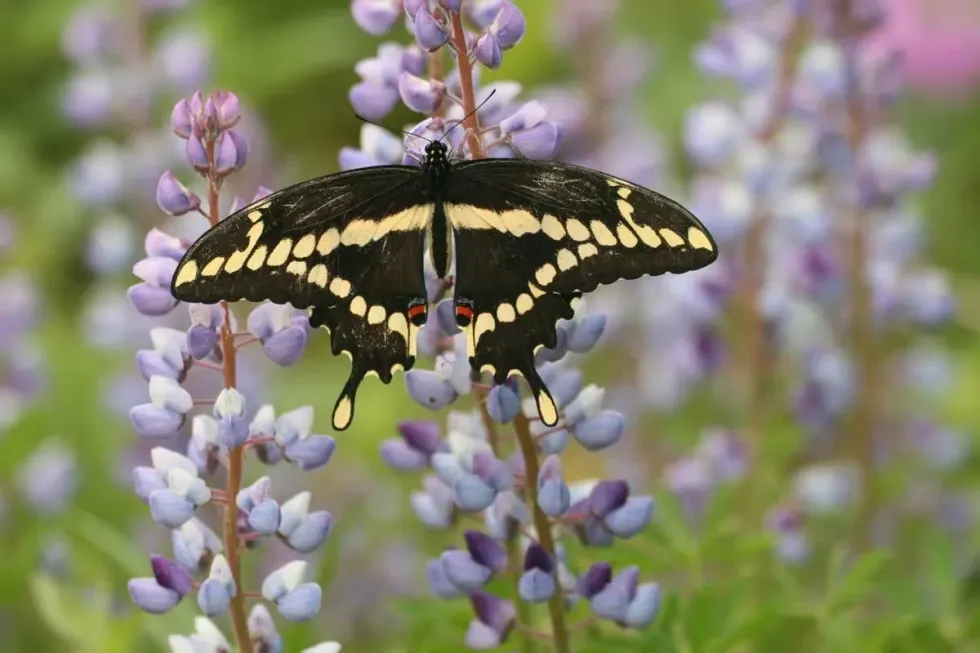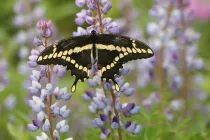Fun Swallowtail Butterfly Facts For Kids
Content
- What type of animal is a giant swallowtail butterfly?
- What class of animal does a giant swallowtail butterfly belong to?
- How many giant swallowtail butterflies are there in the world?
- Where does a giant swallowtail butterfly live?
- What is a giant swallowtail butterfly's habitat?
- Who do giant swallowtail butterflies live with?
- How long does a giant swallowtail butterfly live?
- How do they reproduce?
- What is their conservation status?
- Giant Swallowtail Butterfly Fun Facts
- How cute are they?
- How do they communicate?
- How big is a giant swallowtail butterfly?
- How fast can a giant swallowtail butterfly fly?
- How much does a giant swallowtail butterfly weigh?
- What are the male and female names of their species?
- What would you call a baby giant swallowtail butterfly?
- What do they eat?
- Are they poisonous?
- Would they make a good pet?
- Did you know...
- How does a giant swallowtail butterfly protect itself from predators?
- How is a giant swallowtail butterfly camouflaged?
The giant swallowtail butterfly (Papilio cresphontes cramer), is a North American native butterfly species that is the largest butterfly that can be found in the wild! They are black in color with yellow or orange spots on their wing and have a wingspan of 6 in (15.2 cm).
They are nicknamed the 'orange dog' because the young caterpillars of this butterfly feed mostly on the citrus plants on which they are born. They are a great addition to gardens but their young ones might become pests!
They are commonly found in Northern American regions and prefer to live in open, sunny fields and meadows, and are attracted to gardens due to the amount of nectar that is available there.
Giant swallowtails have a rather short lifespan, the majority of which is spent in caterpillar and larvae form, with the adults living only for six to 14 days, due to which there is not much data on their flight speed or weight.
If you liked these true facts about the giant swallowtail butterfly, then you'll surely like these facts about the monarch butterfly and painted lady butterfly too!
Giant Swallowtail Butterfly Interesting Facts
What type of animal is a giant swallowtail butterfly?
The giant swallowtail (Papilio cresphontes cramer) is a large species of butterfly, that has a striking look to it. The giant swallowtail is abundant in North America, especially Florida.
They can be found all across North America and are welcome guests in gardens too. The giant swallowtail butterfly larvae can be, however, considered a pest as they are harmful to a range of citrus trees in farms and gardens.
What class of animal does a giant swallowtail butterfly belong to?
Giant swallowtails belong to the class of Insecta. Insects usually have an exoskeleton with a three-part body, and they also have three pairs of legs. All insects lay eggs and they are considered to be pests all over the world.
How many giant swallowtail butterflies are there in the world?
There are around 550 species of giant swallowtails in the family Papilionidae. Most of these butterflies are brightly colored and large. Giant swallowtail (Papilio cresphontes cramer) butterflies get their name from their tail which looks like an extension and thus resembles the long tail of the swallow bird.
Where does a giant swallowtail butterfly live?
Most giant swallowtail (Papilio cresphontes cramer) butterflies are found in warm and tropical climates. They are abundant in nature and can be found in a wide variety of ranges and habitats that have several nectar plants for them to feed off of.
What is a giant swallowtail butterfly's habitat?
Giant swallowtail butterflies are distributed widely throughout the North American continent. The giant swallowtail butterfly range is extended in nature and they can be found across the Great Lake states in the northern American region, into Ontario, and through the southern Central Plains portion, and into the Rocky Mountains.
They can also be found on the Caribbean islands, where the Jamaican giant swallowtail butterfly is common.
These butterflies are common throughout the state of Florida too and are active all year in the southern parts of Florida. They are also common in north Florida, excluding the months of January and February.
Who do giant swallowtail butterflies live with?
Giant swallowtails are solitary in nature and are active mostly during the day feeding off host plants such as citrus trees, prickly ash (Zanthoxylum americanum), and herbs from the citrus tree's family. Giant swallowtail caterpillars may be active during day or night and occasionally a few of these spices migrate, but this is uncommon.
How long does a giant swallowtail butterfly live?
Giant swallowtail (Papilio cresphontes cramer) butterflies have a short lifespan from the day they are hatched from the egg to their adult form.
The egg stage of these butterflies is generally four to 10 days long and after that, giant swallowtail caterpillars reach their larvae form in three to four weeks. The giant swallowtail butterfly chrysalis (transformation from immature stage to mature stage) lasts from 10 to 20 days, the exception being during the winter season where it may take longer.
After the chrysalis stage is complete, the fully matured adult giant swallowtail butterfly emerges from the pupa and after that, the adult butterfly lives for six to 14 days before completing the giant swallowtail butterfly life cycle.
How do they reproduce?
The giant swallowtail (Papilio cresphontes cramer) butterfly species reproduces back to back. The male butterfly releases sperm into the abdomen of the female, and she stores it within her until she is ready to lay eggs.
These orange-tinted eggs are laid on host plants like the prickly ash (Zanthoxylum americanum) which the young will grow in and eat through. The eggs have a waxy layer that keeps them from drying out.
Females are picky and will choose only the perfect plant to lay their eggs on. One plant which they tend to choose is the Paw Paw tree that is common in North America.
Pregnant swallowtails will lay their eggs on the surface of the leaves of the host plant, and these eggs are 0.03-0.05 in (0.8-1.3 mm) in size and are spherical in nature. After hatching, the larvae usually feed during the night.
What is their conservation status?
The common giant swallowtail butterfly is listed as a species under the Not Extinct category of insects according to the IUCN. They are found in abundance all over their range, especially in Florida in Northern America.
Giant swallowtails will continue to thrive in nature, even with their short life span, as long as the plants they get their share of nectar from do not end up becoming extinct.
Giant Swallowtail Butterfly Fun Facts

The giant swallowtail (Papilio cresphontes cramer) is named so because of its tail-like extension of the hind wings that resembles the tail of the swallow bird. Their dorsal wings are black in color and have diagonal yellow, red, green, or blue marks on these wings, however, yellow is the most common color.
Differences in color can be found during breeding season or as a means to identify the sex of the swallowtail. Giant swallowtails have one of the largest wingspans that can be found in butterflies.
How cute are they?
Giant swallowtail (Papilio cresphontes cramer) adults are super cute in nature! Even the giant swallowtail caterpillar is cute, but the giant swallowtail butterfly cocoon or pupa isn't partiucarly cute. Pupae resting on plants during the chrysalis stage even look slightly gross and are often harmful to these plants and trees.
How do they communicate?
Adult giant swallowtail (Papilio cresphontes cramer) butterflies can communicate with each other by leaving chemical cues. Males produce pheromones to seduce females during the mating season. A few species of butterflies, like the cracker butterfly, produce a loud noise with their wings that they use as a mode of communication.
How big is a giant swallowtail butterfly?
Giant swallowtails are considered to be one of the biggest butterflies and are larger than most commonly found butterflies. The average wingspan of a male is 5.8-7.4 in (14.8-18.8 cm) and the average wingspan of a female is 5.5-6.9 in (14-17.5 cm).
How fast can a giant swallowtail butterfly fly?
No data is available currently to point out how fast they can fly. However, they are agile in nature and are strong in flight due to their large wingspan. They can cover long distances with just a few flaps of their wings!
How much does a giant swallowtail butterfly weigh?
There is no record of how much the giant swallowtail butterfly weighs. Data deficiency and a lack of knowledge about this species is the cause for this.
What are the male and female names of their species?
There is no specific name assigned to either gender of the swallowtail butterfly. Male and female butterflies can be differentiated in some ways, though.
In the case of the hairstreak butterfly, males often portray a triangular fore-wing compared to the female's more rounded fore-wing. A different wing pattern that is subtle in nature is used to differentiate the two genders of the monarch butterfly and more often than not, females are slightly larger than males, showing signs of sexual dimorphism.
What would you call a baby giant swallowtail butterfly?
A giant swallowtail (Papilio cresphontes cramer) butterfly baby is called a larva. They resemble bird droppings due to their color and due to this, they are very camouflaged and are largely left alone by predators.
Larvae, before achieving the complete adult form of a butterfly, go through four metamorphosis stages of egg, larva (caterpillars), pupa (cocoons), and butterfly.
The giant swallowtail caterpillar can grow up to 1.8 in (4.5 cm) in length! Female giant swallowtails lay their eggs on plants on which the larva hatch and then eat their way through for nutrition.
What do they eat?
The giant swallowtail (Papilio cresphontes cramer) butterfly as an adult will feed on the nectar of host plants like solidago, bougainvillea, citrus leaves, and fruits. As caterpillars, they feed on lime prickly ash, sea touchwood, and a variety of other plants and leaves.
Are they poisonous?
No, giant swallowtails are not poisonous. They are usually docile in nature and are not harmful to humans. However, if you do approach them as caterpillars, they will emit a foul-smelling odor to protect themselves and this smell might not come off easily even if you try to wash it off!
Would they make a good pet?
Giant swallowtails have not been domesticated and it is recommended not to keep them as pets as they love to fly around and spread pollen around, helping in the growth of plants and flowers. Their short lifespan is another issue to consider if you want to keep them as pets.
If you happen to find an egg from the giant swallowtail butterfly then you should follow these instructions to help them grow up healthy! Firstly, you need to get hold of some floral tubes and use them in keeping the host plant secure and fresh until the egg hatches and the caterpillar is born.
Then, cut off thorns on parts of the stem and submerge them in water. Put the cuttings inside the container or cage that the caterpillar is in.
It is important to provide the caterpillar with the best food and care until it reaches the chrysalis stage.
Be patient as the chrysalis stage can take time as this is the final part of the life cycle before the butterfly emerges from the cocoon! Eventually, you will be able to release the butterfly into the wild to complete the process of raising one of these beautiful butterflies!
Did you know...
The giant swallowtail butterfly is one of the largest species of butterfly in the United States! They can also be found in South and Central American regions.
The giant swallowtail is vulnerable to parasites like flies and wasps when they are in their chrysalis stage.
The tiger swallowtail, one of the relatives of the giant swallowtail, is not poisonous in nature but can mimic the poisonous pipevine butterfly that actually is poisonous when they feel a threat to their life.
They are picky and will only eat plants from the citrus family.
Caterpillars are black and white in nature and use this color to their benefit as they resemble bird droppings, so predators tend to leave them alone.
If you do have a black swallowtail as a pet, make sure you feed it lots of plants like leaves of the hop tree (Ptelea trifoliata), celery, parsley, and parsnip.
The preferred giant swallowtail butterfly host plant is found among trees of the citrus family. However, sometimes they will make an exception and make hop treed (Ptelea trifoliata) one of their nesting spots too.
These butterflies might be pretty to look at but they are considered a pest in citrus plantations as they will overpopulate these and their young ones will destroy the plants. The giant swallowtail butterfly as an adult is not harmful, but they are not directly beneficial either. Adults simply use plants and trees as landing zones for laying eggs.
The Jamaican swallowtail is the largest swallowtail butterfly that can be found in the Western Hemisphere! They have a wingspan of 6 in (15.2 cm) and are listed as an Endangered species by the IUCN Red List.
The largest butterfly in the continent of Africa is the African giant swallowtail with a wingspan of 8.1-9.1 in (18-23 cm) and this butterfly is considered to be one of the largest butterflies in the world! Their wings are long and narrow and they are brown colored with black markings.
The swallowtail butterfly is divided into a large category as there are almost 550 species of these butterflies all over the world except in the cold continent of Antarctica.
The giant swallowtail butterfly rolls inside fallen leaves during winter. They will sew their chosen leaf to a twig and then wait for the silk to dry before getting inside it and spending the winter in the safety of these leaves.
How does a giant swallowtail butterfly protect itself from predators?
The giant swallowtail butterfly caterpillar has an organ that is forked in nature located on its head, called an osmeterium. This osmeterium emits a foul-smelling odor in order to thwart predators. When swallowtails are in the chrysalis stage they are prone to danger and have no way to get rid of predators at this point.
How is a giant swallowtail butterfly camouflaged?
Giant swallowtail caterpillars have a distinctive black and white pattern on their body that matches that of bird droppings. Hence they are able to fool predators thanks to this camouflage and keep themselves safe from danger and protect themselves.
Here at Kidadl, we have carefully created lots of interesting family-friendly animal facts for everyone to discover! Learn more about some other insects from our queen butterfly facts and red admiral butterfly facts pages.
You can even occupy yourself at home by coloring in one of our free printable Swallowtail butterfly coloring pages.
We Want Your Photos!
More for You
Bachelor of Arts specializing in Journalism and Mass Communication, Postgraduate Diploma in Sports Management

Moumita DuttaBachelor of Arts specializing in Journalism and Mass Communication, Postgraduate Diploma in Sports Management
A content writer and editor with a passion for sports, Moumita has honed her skills in producing compelling match reports and stories about sporting heroes. She holds a degree in Journalism and Mass Communication from the Indian Institute of Social Welfare and Business Management, Calcutta University, alongside a postgraduate diploma in Sports Management.
Disclaimer
1) Kidadl is independent and to make our service free to you the reader we are supported by advertising. We hope you love our recommendations for products and services! What we suggest is selected independently by the Kidadl team. If you purchase using the Buy Now button we may earn a small commission. This does not influence our choices. Prices are correct and items are available at the time the article was published but we cannot guarantee that on the time of reading. Please note that Kidadl is a participant in the Amazon Services LLC Associates Program, an affiliate advertising program designed to provide a means for sites to earn advertising fees by advertising and linking to Amazon. We also link to other websites, but are not responsible for their content.
2) At Kidadl, we strive to recommend the very best activities and events. We will always aim to give you accurate information at the date of publication - however, information does change, so it’s important you do your own research, double-check and make the decision that is right for your family. We recognise that not all activities and ideas are appropriate for all children and families or in all circumstances. Our recommended activities are based on age but these are a guide. We recommend that these ideas are used as inspiration, that ideas are undertaken with appropriate adult supervision, and that each adult uses their own discretion and knowledge of their children to consider the safety and suitability. Kidadl cannot accept liability for the execution of these ideas, and parental supervision is advised at all times, as safety is paramount. Anyone using the information provided by Kidadl does so at their own risk and we can not accept liability if things go wrong.
3) Because we are an educational resource, we have quotes and facts about a range of historical and modern figures. We do not endorse the actions of or rhetoric of all the people included in these collections, but we think they are important for growing minds to learn about under the guidance of parents or guardians.







